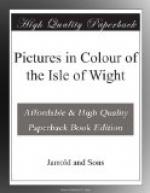Appuldurcombe Abbey.—The ancient seat of the Worsley family, the present building was erected in the eighteenth century by Sir Robert Worsley. Here the Benedictine monks had a Priory in the time of Henry III. It was dissolved by Henry V, Sir Richard Worsley died in 1805, and the house became the property of the Earl of Yarborough, who had married the niece and heiress of the family. After being used as a school for many years, it is now occupied by Benedictine monks, In a beautiful park of four hundred acres, with a lofty down behind it, the house appears to be a well secluded and charming retreat. There is a public footpath through the meadow in front of the house.
[Illustration: Steephill Cove, near Ventnor.]
Steephill Cove, near Ventnor.—Taking the cliff path from Ventnor to the west within a little more than a mile there opens out to view this pretty Cove. It is a place for painters, and its loveliness in all varieties of Nature’s many moods, has found admirers. The cottages nestling under the banks, its parti-coloured gardens, with enclosing pebble walls, its boats and crab-pots, with the distant cliffs in succession, all combine in a composition that strikes the beholder with a conviction of its beauty.
[Illustration: Shanklin Esplanade, from Rylstone.]
Shanklin esplanade, from Rylstone.—This favourite view, which shews nearly the whole of Shanklin Pier, also includes in the distance the Culver Cliff. Taken from the Garden of Rylstone, overlooking the foot of the Chine, it forms a most attractive scene. The cliff pathway on the green to the right, the winding road and broad esplanade, with the wide expanse of sands, furnish a characteristic view of the principal features of Shanklin front. The level sands form a safe and pleasant bathing-ground when covered by the sea. Boating too is popular, it being within easy reach of beautiful bays in the direction of Luccombe.
[Illustration: Gateway, Carisbrooke Castle.]
Gateway, Carisbrooke Castle.—This noble gateway tower was erected by Anthony Woodville, Lord Scales, in the year 1464, and is still in good preservation. The outer gateway was erected in the time of Queen Elizabeth, when a great extension of the grounds enclosed was made.
“The battled towers, the dungeon keep,
The loop-hole grates where captives weep,
The flanking walls that round it sweep
In yellow lustre shone.” (Scott).
The old massive doors have been removed recently and replaced by a lighter structure.
[Illustration: Osborne House Terrace.]
Osborne house.—This view of Osborne from the south lawn is the most picturesque, and gives the late Queen’s apartments standing out in bold relief in the centre of the picture. The terraces below adorn the building, and the rosary which extends on the right to the lawn is gay with a blaze of colour in the month of June. Now that Osborne has been made into a Naval College, the grounds are open to visitors on Fridays in the winter, and on Tuesdays and Fridays in the summer season; it is visited by many thousands during the year.




